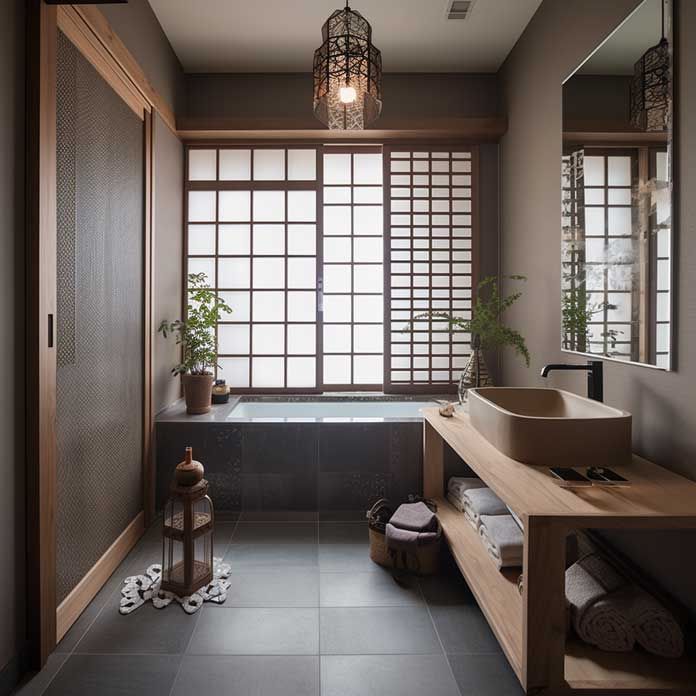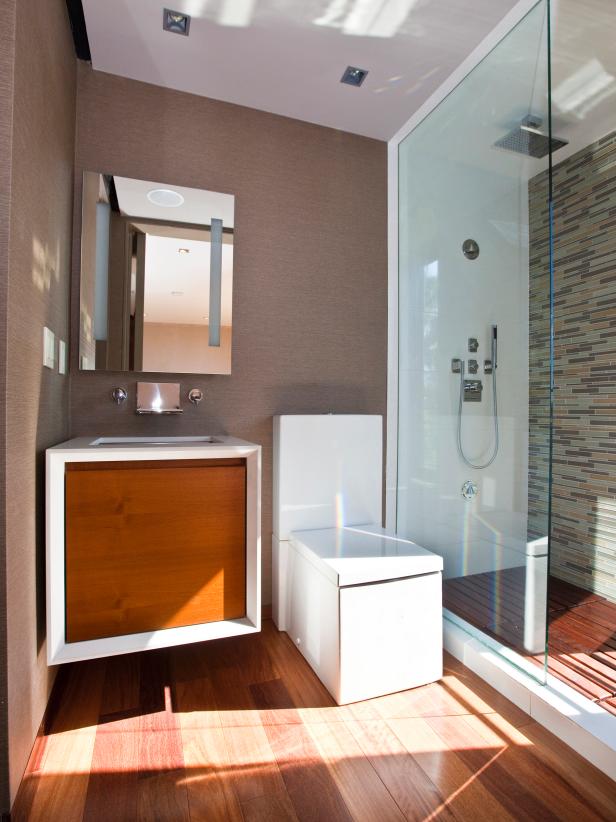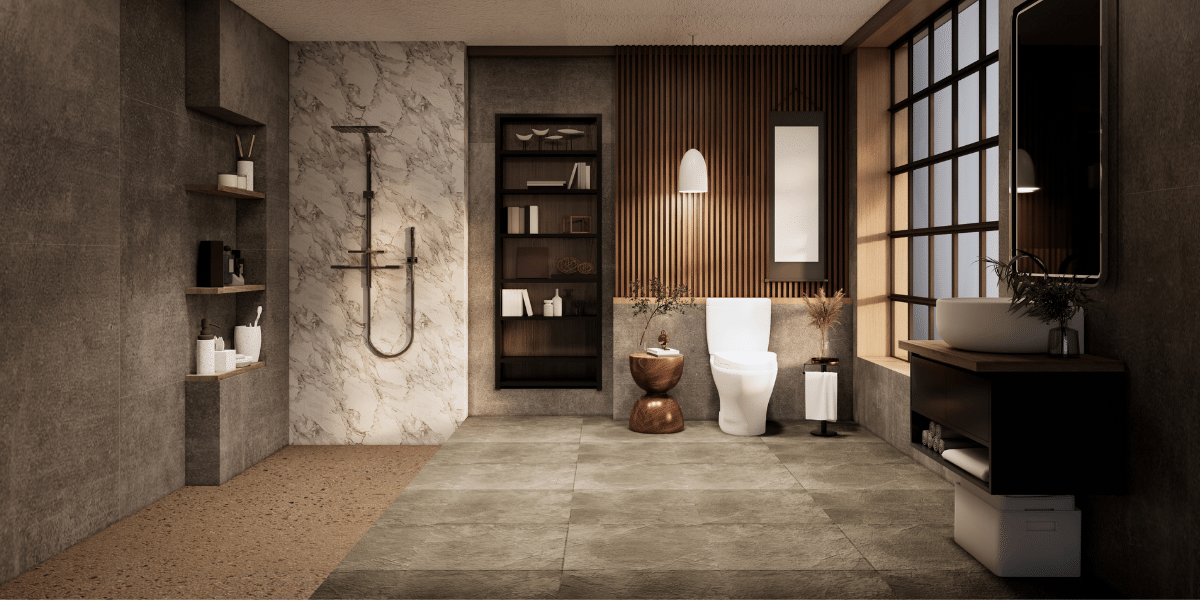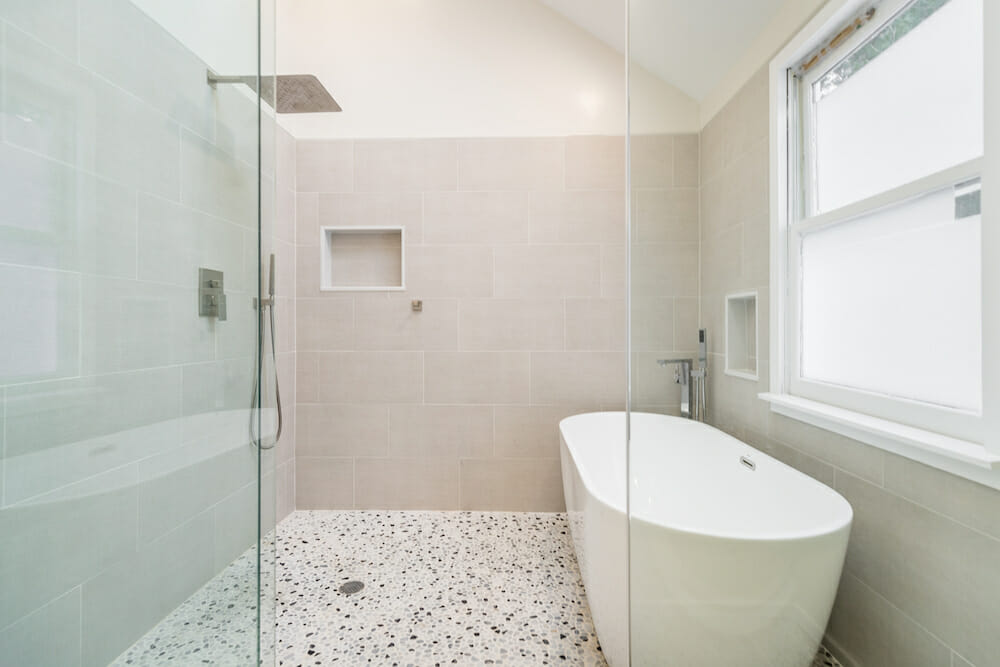
Achieve Tranquility with a Japanese-Style Bathroom
Imagine stepping into a bathroom that isn’t just functional, but a serene escape inspired by nature. This is the essence of a Japanese-style bathroom, designed to promote relaxation and mindfulness through simplicity, clean lines, and natural elements. If you’re looking to transform your bathroom into a tranquil oasis, then consider incorporating these key features of Japanese bathroom design:
Emphasis on Clean Lines and Minimalism
Japanese aesthetics prioritize clean lines, uncluttered spaces, and a focus on natural materials. This translates to a bathroom that is free from unnecessary clutter. Opt for sleek vanities with hidden storage and built-in shelves to minimize visual clutter. Natural light is key, so maximize window space or consider installing skylights.
The Essential Wet Room Concept
A defining characteristic of Japanese bathrooms is the concept of a wet room, where the shower area isn’t separated by a traditional curtain or door. This creates a more open and spacious feel. To achieve this, ensure proper waterproofing of the showering area and install a drain to channel excess water. Opt for a raised wooden platform or pebbles to define the shower space.
The Luxurious Soak: Ofuro Bathtubs
Japanese bathrooms prioritize bathing as a ritual of relaxation. The centerpiece is often a deep soaking tub called an “ofuro.” These tubs are typically made of wood or stone and designed to be filled with hot water for a truly immersive bathing experience. If space is limited, consider a deeper soaking bathtub over a standard tub.

Separate Toilet Area
For reasons of hygiene and privacy, the toilet area is typically separated from the rest of the bathroom in Japanese design. This can be achieved through a small partition wall, a frosted glass divider, or simply by positioning the toilet in a separate alcove.
Natural Materials and Muted Tones
Japanese bathroom design embraces the beauty of nature. Opt for natural materials like wood for vanities, shelves, and flooring. Stone tiles or pebbles can also add a touch of organic texture. When it comes to color, muted tones like beige, cream, and light gray are popular choices, creating a sense of tranquility and reflecting the natural world.
Carefully Placed Accents
While minimalism reigns supreme, a few carefully chosen accents can elevate the space. Bonsai trees, bamboo plants, or simple floral arrangements add a touch of nature’s serenity. Invest in high-quality wooden bath accessories like a bucket and stool to complement the natural aesthetic.
Incorporating Technology Seamlessly
While Japanese design emphasizes tradition, there’s room for modern conveniences. Consider installing high-tech toilets with features like heated seats and bidet functionality. Opt for showers with multiple spray settings for a customizable bathing experience. Remember to integrate technology seamlessly; for example, hide controls behind panels to maintain the minimalist aesthetic.
Lighting for Ambiance
Lighting plays a crucial role in setting the mood in a Japanese bathroom. Opt for soft, diffused lighting that promotes relaxation. Consider recessed lighting or wall sconces with frosted glass shades. Natural light, whenever possible, should be maximized to create a calming and airy atmosphere.
By incorporating these elements, you can transform your bathroom into a Japanese-inspired haven of peace and tranquility. Remember, the key is to embrace simplicity, natural materials, and a focus on creating a space for relaxation and mindfulness.
Tatami Flooring:
For a truly immersive Japanese experience, consider incorporating tatami flooring in your bathroom. Tatami mats are traditionally made from woven rice straw and offer a unique aesthetic and a comfortable underfoot experience. However, it’s important to note that tatami requires special care and maintenance to prevent moisture damage. Ensure proper ventilation in your bathroom and opt for moisture-resistant tatami mats if you choose to go this route.
Ventilation and Airflow:
Since Japanese bathrooms often feature wet rooms, proper ventilation is crucial to prevent moisture buildup and mold growth. Invest in a high-quality exhaust fan that can efficiently remove steam and humidity after showering. Additionally, consider installing operable windows or vents to promote natural airflow and maintain a healthy bathroom environment.
Shoji Screens and Glass Partitions:
While separation is important in Japanese bathrooms, the goal is to maintain a sense of openness. Shoji screens, traditional Japanese dividers made from translucent paper and wooden frames, are a beautiful way to achieve this. They allow light to filter through while providing privacy for the toilet area. Alternatively, frosted glass partitions offer a modern take on separation, maintaining a clean and minimalist aesthetic.
Embrace the Ritual: Bathing Accessories
The Japanese approach to bathing is a ritual of self-care and relaxation. Invest in high-quality wooden bath accessories to elevate the experience. A traditional “ofuro bucket” (hishaku) made from wood is used to scoop water from the tub and cleanse the body. A small wooden stool (shower stool) provides a comfortable place to sit while washing. These accessories not only add a touch of Japanese authenticity but also contribute to the overall bathing ritual.
Creating a Zen Garden Ambiance:
Take inspiration from Japanese Zen gardens to create a calming and meditative atmosphere in your bathroom. Incorporate elements like smooth river rocks or pebbles on the floor of the wet room or around the bathtub. Bonsai trees or other low-maintenance plants can add a touch of life and serenity. Keep the overall plant selection minimal and ensure they thrive in the bathroom’s humidity levels.
Sustainable Practices:
Japanese design philosophy emphasizes harmony with nature. Consider incorporating sustainable practices into your Japanese-style bathroom. Opt for water-efficient toilets and showerheads to conserve water. Utilize natural light whenever possible and choose energy-efficient lighting fixtures. Look for bath products made with natural ingredients and packaged in recyclable materials. By incorporating these sustainable practices, you can create a bathroom that is not only beautiful and tranquil but also environmentally responsible.
Achieving Authenticity: Sourcing Inspiration and Avoiding Clichés
Creating a Japanese-inspired bathroom goes beyond aesthetics. It’s about capturing the essence of Japanese bathing culture, which emphasizes mindfulness and respect for nature. Here are some tips to achieve authenticity and avoid falling into stereotypical clichés:
Seek Inspiration Beyond Tourist Traps:
While traditional Japanese inns (ryokans) and bathhouses (sento) offer a glimpse into Japanese bathing customs, their opulent design may not translate well to a typical home bathroom. Instead, delve deeper and explore Japanese design magazines, architecture websites, and online resources that showcase contemporary Japanese bathroom design. Look for inspiration in minimalist apartments or traditional homes to find ideas that are adaptable to your space and budget.
Focus on Functionality, Not Just Form:
Japanese design prioritizes functionality alongside aesthetics. Don’t get carried away with purely decorative elements that don’t serve a purpose in your bathroom. Every element, from the placement of the toilet to the choice of showerhead, should contribute to a comfortable and functional bathing experience.
Respect the Ritual, Not Just the Look:
The true essence of a Japanese bathroom lies in the bathing ritual itself. Learn about the traditional steps involved, such as thorough cleansing before entering the hot tub soak. Invest in high-quality bathing products and accessories that enhance the ritual, like a loofah (tawashi) for exfoliation or a small washcloth (washilette) for cleansing. By embracing the ritual, your Japanese-inspired bathroom becomes more than just a space; it becomes an experience that promotes relaxation and well-being.

